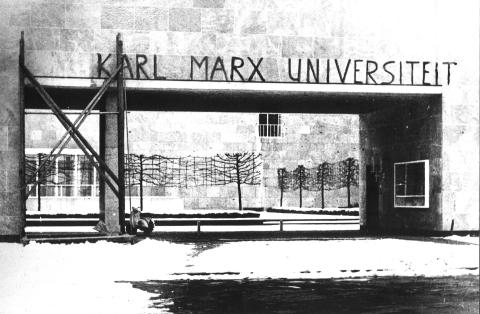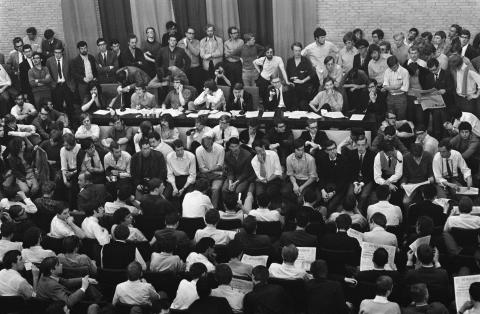Karl Marx University and the occupation
On the night of February 17-18, 1969, around four o'clock, a group of twelve students with ladders, brushes, and red paint snuck up to the entrance gate of the Katholieke Hogeschool Tilburg. They had spent the nights before, taking turns lying in a ditch in front of the building, observing at what times the guards came by. Cold nights they were; there was snow. After a few weeks, they had the schedule figured out. At five o'clock, large letters on the wall above the gate of the main building read "Karl Marx University.” The university bore the name of the nineteenth-century German founder of the labor movement, author of such key works as Das Kapital and the Communistisch Manifest.
With their action, the students called attention to the desired democratization of the university, to the demand for participation. They succeeded brilliantly: a few hours later the text had penetrated all national news media. Rien Siers, photographer for the Tilburgs Hogeschoolblad (now: Univers), was one of the few to take photos of the facade text.
However, the administration was not very accommodating, leading to an occupation of the university on April 28, 1969. It was the first university occupation in the Netherlands; soon after, Amsterdam, Nijmegen, and Groningen, among others, would follow. The conflict over participation prompted a small group of students to enforce their demands by occupying the telephone switchboard. Which, by the way, was extremely easy to pull off. The occupation, however small, made President-Curator Paul van Boven decide to close the Hogeschool. After which Rector Magnificus Cees Scheffer decided to suspend all lectures and exams. For the academic staff, this effectively meant a strike imposed "from above" on all students.
The Tilburg occupation lasted until May 7, and students' demands for participation and reforms in higher education made an impression. The Council of Ministers considered the situation in Tilburg on May 2, 1969. It spoke, also in connection with disturbances in Amsterdam on April 30 and May 1, of an "increasingly widespread authority crisis.”


Action of the democratization of the university (top left image) and the occupation of the university by students in 1969 (top right image)
All the commotion notwithstanding, the occupation was partly behind Veringa's 1971 Wet Universitaire Bestuurshervorming (University Governance Reform Act (WUB)). The curatorium and senate gave way to an Executive Board, monitored by a university council. In addition, each School was given its own board, monitored by a School Council. Students became part of the various councils, thus gaining the influence they desired. In the 1990s, with the introduction of the Dutch University Government (Modernization) Act (Wet modernisering universitaire bestuursorganisatie (MUB)), powers were again significantly reduced.
After the 1969 occupation, Tilburg experienced several shorter occupations. In 1978, when economics students were campaigning for the introduction of the course Political Economy and Social Order (Politieke economie en maatschappelijke orde (PEMO)), the present Cobbenhagen Building was occupied. In 1979, a brief occupation of Koopmans Building took place because of austerity plans at the Faculteit Sociale Wetenschappen. Even the Sports Center was once briefly occupied: in 1984, by angry students who opposed the fact that university of applied sciences students were also allowed access to university’s sports facilities.
More about history and academic heritage
The Tilburg University academic heritage is a very diverse set of archives, visual materials, collections, devices, recorded stories, et cetera that relate to the history of the university.